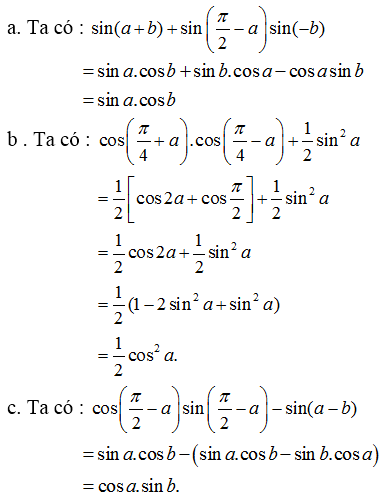Cho a + b = \(\dfrac{\Pi}{4}\). Tính: \(M=\left(1+tana\right)\left(1+tanb\right)\).
Hãy nhập câu hỏi của bạn vào đây, nếu là tài khoản VIP, bạn sẽ được ưu tiên trả lời.


Câu a)
Ta sử dụng 2 công thức:
\(\bullet \tan (180-\alpha)=-\tan \alpha\)
\(\bullet \tan (\alpha+\beta)=\frac{\tan \alpha+\tan \beta}{1-\tan \alpha.\tan \beta}\)
Áp dụng vào bài toán:
\(\text{VT}=\tan A+\tan B+\tan C=\tan A+\tan B+\tan (180-A-B)\)
\(=\tan A+\tan B-\tan (A+B)=\tan A+\tan B-\frac{\tan A+\tan B}{1-\tan A.\tan B}\)
\(=(\tan A+\tan B)\left(1+\frac{1}{1-\tan A.\tan B}\right)=(\tan A+\tan B).\frac{-\tan A.\tan B}{1-\tan A.\tan B}\)
\(=-\tan A.\tan B.\frac{\tan A+\tan B}{1-\tan A.\tan B}=-\tan A.\tan B.\tan (A+B)\)
\(=\tan A.\tan B.\tan (180-A-B)\)
\(=\tan A.\tan B.\tan C=\text{VP}\)
Do đó ta có đpcm
Tam giác $ABC$ có ba góc nhọn nên \(\tan A, \tan B, \tan C>0\)
Áp dụng BĐT Cauchy ta có:
\(P=\tan A+\tan B+\tan C\geq 3\sqrt[3]{\tan A.\tan B.\tan C}\)
\(\Leftrightarrow P=\tan A+\tan B+\tan C\geq 3\sqrt[3]{\tan A+\tan B+\tan C}\)
\(\Rightarrow P\geq 3\sqrt[3]{P}\)
\(\Rightarrow P^3\geq 27P\Leftrightarrow P(P^2-27)\geq 0\)
\(\Rightarrow P^2-27\geq 0\Rightarrow P\geq 3\sqrt{3}\)
Vậy \(P_{\min}=3\sqrt{3}\). Dấu bằng xảy ra khi \(\angle A=\angle B=\angle C=60^0\)
Câu b)
Ta sử dụng 2 công thức chính:
\(\bullet \tan (\alpha+\beta)=\frac{\tan \alpha+\tan \beta}{1-\tan \alpha.\tan \beta}\)
\(\bullet \tan (90-\alpha)=\frac{1}{\tan \alpha}\)
Áp dụng vào bài toán:
\(\text{VT}=\tan \frac{A}{2}.\tan \frac{B}{2}+\tan \frac{B}{2}.\tan \frac{C}{2}+\tan \frac{C}{2}.\tan \frac{A}{2}\)
\(=\tan \frac{A}{2}.\tan \frac{B}{2}+\tan \frac{C}{2}(\tan \frac{A}{2}+\tan \frac{B}{2})\)
\(=\tan \frac{A}{2}.\tan \frac{B}{2}+\tan (90-\frac{A+B}{2})(\tan \frac{A}{2}+\tan \frac{B}{2})\)
\(=\tan \frac{A}{2}.\tan \frac{B}{2}+\frac{\tan \frac{A}{2}+\tan \frac{B}{2}}{\tan (\frac{A+B}{2})}\)
\(=\tan \frac{A}{2}.\tan \frac{B}{2}+\frac{\tan \frac{A}{2}+\tan \frac{B}{2}}{\frac{\tan \frac{A}{2}+\tan \frac{B}{2}}{1-\tan \frac{A}{2}.\tan \frac{B}{2}}}\)
\(=\tan \frac{A}{2}.\tan \frac{B}{2}+1-\tan \frac{A}{2}.\tan \frac{B}{2}=1=\text{VP}\)
Ta có đpcm.
Cũng giống phần a, ta biết do ABC là tam giác nhọn nên
\(\tan A, \tan B, \tan C>0\)
Đặt \(\tan A=x, \tan B=y, \tan C=z\). Ta có: \(xy+yz+xz=1\)
Và \(T=x+y+z\)
\(\Rightarrow T^2=x^2+y^2+z^2+2(xy+yz+xz)\)
Theo hệ quả quen thuộc của BĐT Cauchy:
\(x^2+y^2+z^2\geq xy+yz+xz\)
\(\Rightarrow T^2\geq 3(xy+yz+xz)=3\)
\(\Rightarrow T\geq \sqrt{3}\Leftrightarrow T_{\min}=\sqrt{3}\)
Dấu bằng xảy ra khi \(x=y=z=\frac{1}{\sqrt{3}}\Leftrightarrow \angle A=\angle B=\angle C=60^0\)

mình làm cách này là cách khj nào mà ko cách nào khác ms làm vậy thôi, áp dụng định lí sin và cosin trong tam giác


rút gọn biểu thức:
E=cos(\(\dfrac{3\pi}{3}-\alpha\))-sin(\(\dfrac{3\pi}{2}-\alpha\))+sin(\(\alpha+4\pi\))

Bài 1:
a)
\(\sin ^2x+\sin ^2x\cot^2x=\sin ^2x(1+\cot^2x)=\sin ^2x(1+\frac{\cos ^2x}{\sin ^2x})\)
\(=\sin ^2x.\frac{\sin ^2x+\cos^2x}{\sin ^2x}=\sin ^2x+\cos^2x=1\)
b)
\((1-\tan ^2x)\cot^2x+1-\cot^2x\)
\(=\cot^2x(1-\tan^2x-1)+1=\cot^2x(-\tan ^2x)+1=-(\tan x\cot x)^2+1\)
\(=-1^2+1=0\)
c)
\(\sin ^2x\tan x+\cos^2x\cot x+2\sin x\cos x=\sin ^2x.\frac{\sin x}{\cos x}+\cos ^2x.\frac{\cos x}{\sin x}+2\sin x\cos x\)
\(=\frac{\sin ^3x}{\cos x}+\frac{\cos ^3x}{\sin x}+2\sin x\cos x=\frac{\sin ^4x+\cos ^4x+2\sin ^2x\cos ^2x}{\sin x\cos x}=\frac{(\sin ^2x+\cos ^2x)^2}{\sin x\cos x}=\frac{1}{\sin x\cos x}\)
\(=\frac{1}{\frac{\sin 2x}{2}}=\frac{2}{\sin 2x}\)
Bài 2:
Áp dụng BĐT Cauchy Schwarz ta có:
\(P=\frac{a^2}{\sqrt{a(2c+a+b)}}+\frac{b^2}{\sqrt{b(2a+b+c)}}+\frac{c^2}{\sqrt{c(2b+c+a)}}\)
\(\geq \frac{(a+b+c)^2}{\sqrt{a(2c+a+b)}+\sqrt{b(2a+b+c)}+\sqrt{c(2b+c+a)}}(*)\)
Tiếp tục áp dụng BĐT Cauchy-Schwarz:
\((\sqrt{a(2c+a+b)}+\sqrt{b(2a+b+c)}+\sqrt{c(2b+c+a)})^2\leq (a+b+c)(2c+a+b+2a+b+c+2b+c+a)\)
\(\Leftrightarrow (\sqrt{a(2c+a+b)}+\sqrt{b(2a+b+c)}+\sqrt{c(2b+c+a)})^2\leq 4(a+b+c)^2\)
\(\Rightarrow \sqrt{a(2c+a+b)}+\sqrt{b(2a+b+c)}+\sqrt{c(2b+c+a)}\leq 2(a+b+c)(**)\)
Từ \((*); (**)\Rightarrow P\geq \frac{(a+b+c)^2}{2(a+b+c)}=\frac{a+b+c}{2}=\frac{3}{2}\)
Vậy \(P_{\min}=\frac{3}{2}\)
Dấu "=" xảy ra khi $a=b=c=1$

a, ĐK: \(x\ne\dfrac{5\pi}{6}+k2\pi;x\ne\dfrac{\pi}{6}+k2\pi\)
\(\dfrac{2sin^2\left(\dfrac{3x}{2}-\dfrac{\pi}{4}\right)+\sqrt{3}cos^3x\left(1-3tan^2x\right)}{2sinx-1}=-1\)
\(\Leftrightarrow2sin^2\left(\dfrac{3x}{2}-\dfrac{\pi}{4}\right)+\sqrt{3}cos^3x\left(1-3tan^2x\right)=1-2sinx\)
\(\Leftrightarrow-cos\left(3x-\dfrac{\pi}{2}\right)+\sqrt{3}cos^3x.\dfrac{cos^2x-3sin^2x}{cos^2x}=-2sinx\)
\(\Leftrightarrow-sin3x+\sqrt{3}cosx.\left(cos^2x-3sin^2x\right)=-2sinx\)
\(\Leftrightarrow-sin3x+\sqrt{3}cosx.\left(4cos^2x-3\right)=-2sinx\)
\(\Leftrightarrow-sin3x+\sqrt{3}cos3x=-2sinx\)
\(\Leftrightarrow\dfrac{1}{2}sin3x-\dfrac{\sqrt{3}}{2}cos3x-sinx=0\)
\(\Leftrightarrow sin\left(3x-\dfrac{\pi}{3}\right)-sinx=0\)
\(\Leftrightarrow2cos\left(2x-\dfrac{\pi}{6}\right)sin\left(x-\dfrac{\pi}{6}\right)=0\)
\(\Leftrightarrow\left[{}\begin{matrix}cos\left(2x-\dfrac{\pi}{6}\right)=0\\sin\left(x-\dfrac{\pi}{6}\right)=0\end{matrix}\right.\)
\(\Leftrightarrow\left[{}\begin{matrix}2x-\dfrac{\pi}{6}=\dfrac{\pi}{2}+k\pi\\x-\dfrac{\pi}{6}=k\pi\end{matrix}\right.\)
\(\Leftrightarrow\left[{}\begin{matrix}x=\dfrac{\pi}{3}+\dfrac{k\pi}{2}\\x=\dfrac{\pi}{6}+k\pi\end{matrix}\right.\)
Đối chiếu điều kiện ta được:
\(\Leftrightarrow\left[{}\begin{matrix}x=\dfrac{\pi}{3}+k\pi\\x=\dfrac{7\pi}{6}+k2\pi\\x=-\dfrac{\pi}{6}+k2\pi\end{matrix}\right.\)
(Giả sử chọn k=-1)
Đặt \(u_n=v_n-1\Rightarrow v_{n+1}-1=\dfrac{5\left(v_n-1\right)+4}{v_n-1+2}=\dfrac{5v_n-1}{v_n+1}\)
\(\Rightarrow v_{n+1}=1+\dfrac{5v_n-1}{v_n+1}=\dfrac{6v_n}{v_n+1}\)
Mục đích chỉ cần biến đổi tới đây, sau đó nghịch đảo 2 vế:
\(\Rightarrow\dfrac{1}{v_{n+1}}=\dfrac{v_n+1}{6v_n}=\dfrac{1}{6v_n}+\dfrac{1}{6}\)
Đặt \(\dfrac{1}{v_n}=x_n\Rightarrow\left\{{}\begin{matrix}x_1=\dfrac{1}{v_1}=\dfrac{1}{u_1+1}=\dfrac{1}{6}\\x_{n+1}=\dfrac{1}{6}x_n+\dfrac{1}{6}\end{matrix}\right.\)
Rồi đó, đưa về dãy cơ bản \(\Rightarrow x_{n+1}-\dfrac{1}{5}=\dfrac{1}{6}\left(x_n-\dfrac{1}{5}\right)\)
Đặt \(x_n-\dfrac{1}{5}=y_n\Rightarrow\left\{{}\begin{matrix}y_1=x_1-\dfrac{1}{5}=-\dfrac{1}{30}\\y_{n+1}=\dfrac{1}{6}y_n\end{matrix}\right.\)
\(\Rightarrow y_n=-\dfrac{1}{30}\left(\dfrac{1}{6}\right)^{n-1}\Rightarrow x_n=y_n+\dfrac{1}{5}=-\dfrac{1}{30}.\left(\dfrac{1}{6}\right)^{n-1}+\dfrac{1}{5}\)
\(\Rightarrow v_n=\dfrac{1}{x_n}=...\Rightarrow u_n=v_n-1=\dfrac{1}{x_n}-1=...\)
Cách này là cách cơ bản, có hướng làm cố định để đưa về các dãy quen thuộc

a.
\(\sqrt{2}sin\left(2x+\dfrac{\pi}{4}\right)=3sinx+cosx+2\)
\(\Leftrightarrow sin2x+cos2x=3sinx+cosx+2\)
\(\Leftrightarrow2sinx.cosx-3sinx+2cos^2x-cosx-3=0\)
\(\Leftrightarrow sinx\left(2cosx-3\right)+\left(cosx+1\right)\left(2cosx-3\right)=0\)
\(\Leftrightarrow\left(2cosx-3\right)\left(sinx+cosx+1\right)=0\)
\(\Leftrightarrow\left[{}\begin{matrix}cosx=\dfrac{3}{2}\left(vn\right)\\sinx+cosx+1=0\end{matrix}\right.\)
\(\Rightarrow\sqrt{2}sin\left(x+\dfrac{\pi}{4}\right)=-1\)
\(\Leftrightarrow sin\left(x+\dfrac{\pi}{4}\right)=-\dfrac{\sqrt{2}}{2}\)
\(\Leftrightarrow...\)
b.
ĐKXĐ: \(cosx\ne\dfrac{1}{2}\Rightarrow\left[{}\begin{matrix}x\ne\dfrac{\pi}{3}+k2\pi\\x\ne-\dfrac{\pi}{3}+k2\pi\end{matrix}\right.\)
\(\dfrac{\left(2-\sqrt{3}\right)cosx-2sin^2\left(\dfrac{x}{2}-\dfrac{\pi}{4}\right)}{2cosx-1}=1\)
\(\Rightarrow\left(2-\sqrt{3}\right)cosx+cos\left(x-\dfrac{\pi}{2}\right)=2cosx\)
\(\Leftrightarrow-\sqrt{3}cosx+sinx=0\)
\(\Leftrightarrow sin\left(x-\dfrac{\pi}{3}\right)=0\)
\(\Rightarrow x-\dfrac{\pi}{3}=k\pi\)
\(\Rightarrow x=\dfrac{\pi}{3}+k\pi\)
Kết hợp ĐKXĐ \(\Rightarrow x=\dfrac{4\pi}{3}+k2\pi\)

\(1=tan\left(\dfrac{\pi}{4}\right)=tan\left(a+b\right)=\dfrac{tana+tanb}{1-tana.tanb}\)
\(\Rightarrow tana+tanb=1-tana.tanb\)
\(\Rightarrow tana+tanb+tana.tanb=1\)
Do đó:
\(M=1+tana+tanb+tana.tanb=1+1=2\)